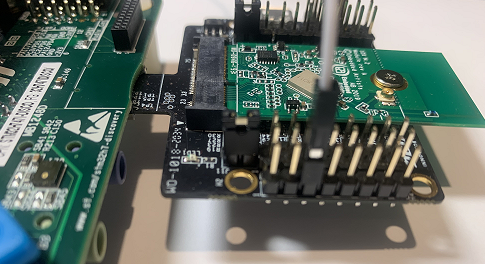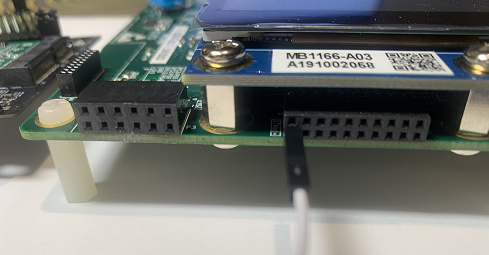This application demonstrates mDNS on Cypress module for the STM32H747I board.
It performs mDNS services announce and deannounce functions using the NetxDuo stack.
- Application announces and deannounces various mDNS services and displays the same on the UART.
None
- The application is using the DHCP to acquire IP address, thus a DHCP server should be reachable by the board in the LAN used to test the application.
-
ThreadX uses the Systick as time base, thus it is mandatory that the HAL uses a separate time base through the TIM IPs.
-
ThreadX is configured with 1000 ticks/sec, this should be taken into account when using delays or timeouts at application. It is always possible to reconfigure it in the
tx_user.h, theTX_TIMER_TICKS_PER_SECONDdefine, but this should be reflected intx_initialize_low_level.Sfile too. -
ThreadX is disabling all interrupts during kernel start-up to avoid any unexpected behavior, therefore all system related calls (HAL, BSP) should be done either at the beginning of the application or inside the thread entry functions.
-
ThreadX offers the
tx_application_define()function, that is automatically called by the tx_kernel_enter() API. It is highly recommended to use it to create all applications ThreadX related resources (threads, semaphores, memory pools...) but it should not in any way contain a system API call (HAL or BSP). -
Using dynamic memory allocation requires to apply some changes to the linker file. ThreadX needs to pass a pointer to the first free memory location in RAM to the
tx_application_define()function, using thefirst_unused_memoryargument. This requires changes in the linker files to expose this memory location.- For EWARM add the following section into the .icf file:
place in RAM_region { last section FREE_MEM };- For MDK-ARM:
either define the RW_IRAM1 region in the ".sct" file
or modify the line below in
tx_initialize_low_level.Sto match the memory region being used
LDR r1, =|Image$$RW_IRAM1$$ZI$$Limit|- For STM32CubeIDE add the following section into the .ld file:
._threadx_heap : { . = ALIGN(8); __RAM_segment_used_end__ = .; . = . + 64K; . = ALIGN(8); } >RAM_D1 AT> RAM_D1The simplest way to provide memory for ThreadX is to define a new section, see ._threadx_heap above. In the example above the ThreadX heap size is set to 64KBytes. The
._threadx_heapmust be located between the.bssand the._user_heap_stack sectionsin the linker script. Caution: Make sure that ThreadX does not need more than the provided heap memory (64KBytes in this example). Read more in STM32CubeIDE User Guide, chapter: "Linker script".- The
tx_initialize_low_level.Sshould be also modified to enable theUSE_DYNAMIC_MEMORY_ALLOCATIONcompilation flag.
For more details about the MPU configuration please refer to the AN4838
RTOS, Network, ThreadX, NetXDuo, mDNS, WiFi, Station mode, microSD
-
This application runs on STM32H747xx devices.
-
This application has been tested with STMicroelectronics STM32H747I-DISCO boards Revision: MB1248-H747I-D02 and can be easily tailored to any other supported device and development board.
-
A daughter board with the WiFi module is to be plugged into the microSD card connector CN12 of the STM32H747I-DISCO board.
-
The daughter board that was used is made up of:
- A Murata uSD-M.2 Adapter Kit rev A (J1 position 2-3, VBAT from microSD connector)
- The 1DX M.2 Module for the Cypress WiFi (CYW4343W)
Connect Pin 20 of STMod+ connector P2 of STM32H747I-DISCO to the uSD M.2 Adapter (J9 pin3 WL_REG_ON_HOST) that supports the Cypress device as described with the below pictures:
-
This application uses USART1 to provide a console for commands, the hyperterminal configuration is as follows:
- BaudRate = 115200 baud
- Word Length = 8 Bits
- Stop Bit = 1
- Parity = None
- Flow control = None
- Line endings set to LF (receive).
-
This application requires a WiFi access point to connect to:
- With a transparent Internet connectivity: no proxy, no firewall blocking the outgoing traffic.
- Running a DHCP server delivering the IP and DNS configuration to the board.
-
Development PC with the Bonjour SDK installed and connected to the same WiFi access point as the board.
- This is used to verify the services being announced/deannounced.
In order to make the program work, you must do the following:
-
Open your preferred toolchain
-
Edit the file
CM7/Core/Inc/cy_wifi_conf.hto enter the name of your WiFi access point (WIFI_SSID) to connect to and its password (WIFI_PASSWORD). -
For each target configuration (Nx_MDNS_wifi_CM4 first then Nx_MDNS_wifi_CM7) :
- Rebuild all files
- Load images into target memory
-
After loading the two images, you have to reset the board in order to boot (Cortex-M7) and CPU2 (Cortex-M4) at once.
-
Enter the following commands in a Command Prompt window (you may open multiple windows for each command) to verify the services being announced/deannounced:
-
C:\Windows\System32> dns-sd.exe -L test_announce _test_st local -
C:\Windows\System32> dns-sd.exe -L test_announce1 _test_st local -
C:\Windows\System32> dns-sd.exe -L test_announce2 _test_st local -
C:\Windows\System32> dns-sd.exe -L test_announce3 _test_st local -
C:\Windows\System32> dns-sd.exe -B _test_st local
-
-
Run the application
-
One can also ping the device using the hostname to verify the automatic IPv4 address resolved by mDNS:
C:\Windows\System32> ping.exe mDNS-HOST.local
-
Application announces and deannounces various mDNS services and displays the same on the UART.

